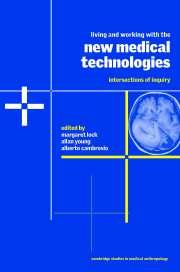Book contents
- Frontmatter
- Contents
- List of contributors
- 1 Introduction
- Part I Epochal transitions? Biomedicine and the transformation of socionature
- Part II Laboratories and clinics: the material cultures of biomedicine
- 4 Trustworthy knowledge and desperate patients: clinical tests for new drugs from cancer to AIDS
- 5 Pathology and the clinic: an ethnographic presentation of two atheroscleroses
- 6 “Real compared to what?”: Diagnosing leukemias and lymphomas
- 7 History, hystery and psychiatric styles of reasoning
- Part III Technologies and bodies: the extended networks of biomedicine
- Index
4 - Trustworthy knowledge and desperate patients: clinical tests for new drugs from cancer to AIDS
Published online by Cambridge University Press: 23 December 2009
- Frontmatter
- Contents
- List of contributors
- 1 Introduction
- Part I Epochal transitions? Biomedicine and the transformation of socionature
- Part II Laboratories and clinics: the material cultures of biomedicine
- 4 Trustworthy knowledge and desperate patients: clinical tests for new drugs from cancer to AIDS
- 5 Pathology and the clinic: an ethnographic presentation of two atheroscleroses
- 6 “Real compared to what?”: Diagnosing leukemias and lymphomas
- 7 History, hystery and psychiatric styles of reasoning
- Part III Technologies and bodies: the extended networks of biomedicine
- Index
Summary
Transforming the “Art of Healing” into a Science: Origins of the Controlled, Randomized Clinical Trial
This chapter discusses a “soft” biomedical technology: the randomized, controlled clinical trial. Clinical trials of new drugs were often presented as “transparent devices,” a non-problematic, and thus non-problematized way to evaluate new therapies. The development of the “controlled randomized trial” in the 1940s and 1950s was according to the official histories of this technique a step that moved the “art of healing” from a “pre-scientific” to a “scientific stage.” It eliminated the subjective element in the evaluation of new treatments, and replaced it with quantitative and objective data, radically separating the “hard” scientific aspect of healing from its “soft” social and cultural aspects (Bloom 1986). Doctors were always aware that their healing activity has a “non-scientific” dimension. In his book, The Principles of Medical Knowledge, published in 1902, the Polish philosopher of medicine, Edmund Biernacki, distinguished between the “science of diseases” and the “art of healing.” The science of diseases (physiology and pathology), he explained, can claim scientific status because it is based on objective observations and on experimentation. Therapies, however, cannot be considered an exact science. They were, as a rule, developed through empirical bedside tinkering while their results were intrinsically “non-scientific” because they depended on the highly individualized and idiosyncratic patient–healer relationship and were influenced by the patient's (and doctor's) belief that a given therapy would work. “Suggestion can bring better mental equilibrium and better feeling, and can influence in a positive way even the most material perturbations of vegetative functions of the organism” (Biernacki 1902: 297).
- Type
- Chapter
- Information
- Living and Working with the New Medical TechnologiesIntersections of Inquiry, pp. 49 - 81Publisher: Cambridge University PressPrint publication year: 2000
- 38
- Cited by



